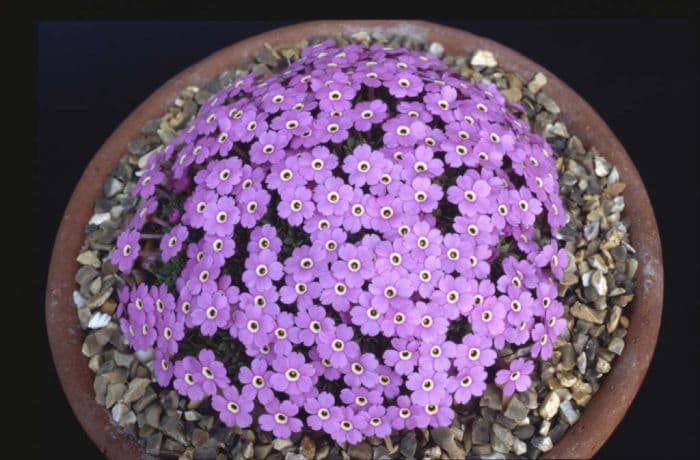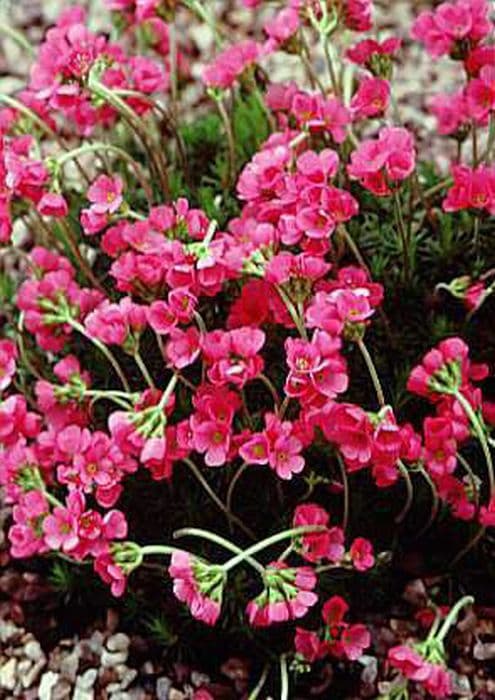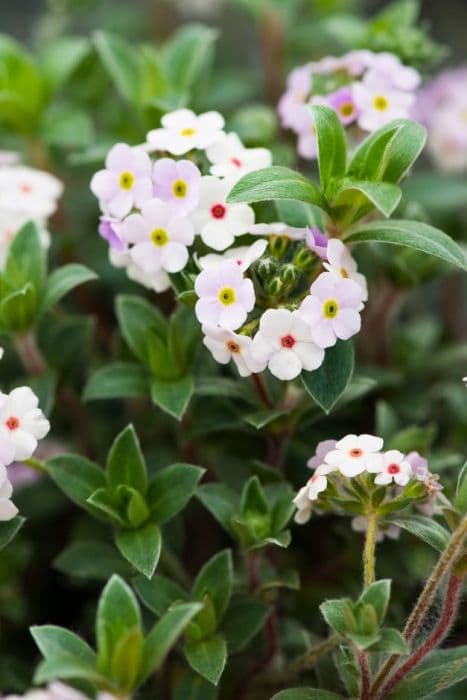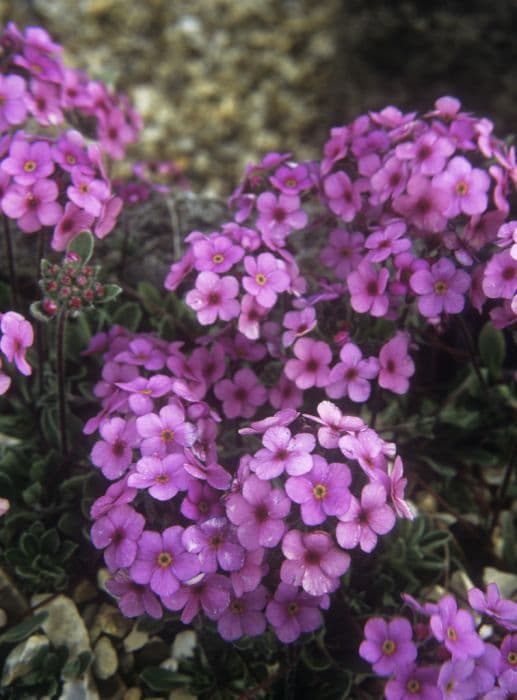Dionysia Dionysia 'Chris Grey-wilson'

ABOUT
The Dionysia 'Chris Grey-Wilson' is a captivating evergreen perennial known for its exquisite cushion or dome-like growth habit, making it an exceptional choice for rockeries or alpine gardens. The plant boasts dense, compact rosettes of tiny, oblong to spoon-shaped leaves, which are often a lush green with an attractive, contrasting layer of downy white hairs that can give them a silvery appearance. During the blooming period, this variety becomes especially ornamental with a profusion of vibrant, trumpet-shaped flowers that grow in clusters. The blooms can vary in color, showcasing shades that range from deep yellow to pink, creating a stunning visual display against the backdrop of its foliage. The flowers are usually richly pigmented and stand out for their beauty and the way they cover the plant in abundance. With its small, intricate leaves and eye-catching blooms, the Dionysia 'Chris Grey-Wilson' is known for its aesthetic appeal and delicate charm. It is a choice plant for enthusiasts who value intricate foliage and floriferous displays in their garden, especially appealing to those who appreciate the enchanting beauty of alpine plant species.
About this plant
 Names
NamesFamily
Primulaceae
Synonyms
Unfortunately, there are no widely recognized common names for Dionysia 'Chris Grey-wilson', as it is generally referred to by its botanical name.
Common names
Dionysia 'Chris Grey-wilson'.
 Toxicity
ToxicityTo humans
Dionysia 'Chris Grey-wilson', commonly known as just Dionysia, does not have a well-documented profile when it comes to toxicity to humans. There is no widespread evidence suggesting that the plant is toxic. However, as with any plant not typically used for food, it is generally advisable to avoid ingesting it due to the potential for individual allergic reactions or unknown toxicities. If a person mistakenly ingests Dionysia and experiences adverse symptoms, it would be wise to consult a medical professional.
To pets
Dionysia 'Chris Grey-wilson', commonly referred to as Dionysia, is not commonly listed among plants that are known to be toxic to pets. However, the lack of specific information means that caution should still be exercised to prevent pets from ingesting the plant. As with humans, individual pets may have sensitivity to plants that are not generally recognized as toxic, and ingestion could potentially lead to gastrointestinal upset or allergic reactions. If a pet ingests Dionysia and shows signs of distress or illness, it is recommended to contact a veterinarian immediately.
 Characteristics
CharacteristicsLife cycle
Perennials
Foliage type
Evergreen
Color of leaves
Green
Flower color
Varies
Height
0.16 feet (5 cm)
Spread
0.5 feet (15 cm)
Plant type
Herb
Hardiness zones
5
Native area
Iran
Benefits
 General Benefits
General Benefits- Aesthetic Appeal - Dionysia 'Chris Grey-Wilson', with its vibrant flowers, adds color and visual interest to gardens or indoor spaces.
- Habitat for Wildlife - It can provide food and shelter for certain insects, supporting local biodiversity.
- Low Maintenance - This plant generally requires minimal care once established, making it suitable for low-maintenance gardening.
- Compact Growth - Its small, compact size makes it ideal for rock gardens, containers, or small spaces.
- Drought Tolerance - Being a hardy plant, it can withstand dry conditions better than many other species once established.
- Education and Hobby - Growing Dionysia offers an opportunity for learning about alpine plants and can be a satisfying hobby.
- Seasonal Interest - It typically blooms in spring, providing early seasonal interest after the winter months.
 Medical Properties
Medical PropertiesThis plant is not used for medical purposes.
 Air-purifying Qualities
Air-purifying QualitiesThis plant is not specifically known for air purifying qualities.
 Other Uses
Other Uses- Dye Production: The flowers of the Dionysia can sometimes yield dyes for fabric, offering subtle hues to textiles.
- Photography Subject: Due to its distinctive appearance, Dionysia can serve as a unique subject for botanical photographers seeking to capture the beauty of alpine plants.
- Education: The specific growing requirements of Dionysia make it an excellent example for educational purposes in horticultural classes, demonstrating cultivation techniques for alpine plants.
- Crafts: Pressed Dionysia flowers can be used in craft projects such as homemade cards, bookmarks, and scrapbooking, adding a touch of natural beauty to creative works.
- Miniature Gardening: Dionysia's small size makes it an ideal choice for fairy gardens or miniature scenes where tiny, realistic vegetation is desired.
- Ice Cubes: Frozen petals of Dionysia in ice cubes can add an elegant touch to decorative drinks for garden parties or special events.
- Collector's Specimen: Dionysia varieties are often sought after by plant collectors looking to add rare or unusual species to their alpine plant collections.
- Culinary Decoration: Although not edible, Dionysia can be used as a non-toxic decorative garnish for dishes in high-end culinary presentations.
- Seed Exchange: The seeds of Dionysia can be shared amongst enthusiasts participating in seed swap events, helping to preserve the species and its varieties.
- Penmanship Practice: Leaves and stems of Dionysia plants could potentially be used as fine templates or guides for artists practicing intricate penmanship or calligraphy.
Interesting Facts
 Feng Shui
Feng ShuiThe Dionysia is not used in Feng Shui practice.
 Zodiac Sign Compitability
Zodiac Sign CompitabilityThe Dionysia is not used in astrology practice.
 Plant Symbolism
Plant SymbolismUnfortunately, as of my knowledge cutoff in 2023, Dionysia 'Chris Grey-Wilson' does not have a widely recognized set of symbolic meanings. Dionysia, a genus in the family Plantaginaceae, commonly includes small alpine plants not typically known for their symbolism in the way that flowers like roses or lilies are. It is also possible that this particular cultivar, named after a botanist, does not have an established common name that is widely recognized. As a result, there isn't a symbolic meaning list to provide for the Dionysia 'Chris Grey-Wilson'. It's worth noting that plant symbolism can vary by culture and context, but without a recognized common name or traditional uses that imbue the plant with specific meanings, no such list exists for this plant.
 Water
WaterThe Dionysia, also known as cushion bush, requires consistent moisture but dislikes waterlogged conditions. It is best to water it once a week with approximately a quarter of a gallon of water, ensuring that the water penetrates the soil well without leaving standing water. During the growing season in spring and summer, keep the soil slightly moist, and reduce watering in the winter months when the plant is dormant. Always check the top inch of soil for dryness before watering again to avoid over-watering.
 Light
LightDionysia thrives in bright, indirect light, making an east or west-facing window an ideal spot for this cushion bush. It can also tolerate some direct morning sun but should be protected from the intense afternoon sun to prevent leaf scorch. The plant will benefit from a few hours of direct sunlight each day but needs shade during the hottest part of the day.
 Temperature
TemperatureCushion bush prefers cooler temperatures and can survive in a range between 40 to 80 degrees Fahrenheit, though it thrives best when the temperature is between 50 and 70 degrees. It can handle occasional dips below the minimum temperature for short periods but should be protected from extreme cold and frost.
 Pruning
PruningPruning cushion bush is essential to maintain its compact shape and to encourage healthy growth. Trim back the plant lightly after it has finished flowering to remove dead flowers and shape the plant. Pruning should be done annually or as needed to keep the plant from becoming leggy.
 Cleaning
CleaningAs needed
 Soil
SoilDionysia 'Chris Grey-wilson', commonly known as a type of Primrose, thrives in a well-draining, gritty mix with sharp sand and small pebbles to mimic its native rocky habitats. It prefers a slightly acidic to neutral soil pH, ranging from 6.0 to 7.0.
 Repotting
RepottingDionysia 'Chris Grey-wilson' or Primrose should be repotted every 1-2 years to refresh the soil and prevent the roots from becoming pot-bound, ideally in the spring before the onset of new growth.
 Humidity & Misting
Humidity & MistingDionysia 'Chris Grey-wilson' requires moderate to high humidity levels, ideally around 40-50%, to thrive indoors. Too low humidity can lead to stress and leaf problems.
 Suitable locations
Suitable locationsIndoor
Ensure bright light, cool temps, and high humidity.
Outdoor
Protect from hot sun, water regularly, provide gritty soil.
Hardiness zone
5-7 USDA
 Life cycle
Life cycleThe Dionysia 'Chris Grey-Wilson', commonly known as a type of cushion plant or alpine plant, begins its life as a seed, which, under appropriate conditions of temperature and moisture, germinates to produce a small seedling. The seedling grows slowly, forming a compact, low-growing habit typical of many alpine plants, which helps protect it from the harsh conditions of its natural habitat. As it matures, it develops a thick taproot and a cushion or mat-like structure composed of tight rosettes of leaves. This perennial plant blooms during spring or early summer, producing small, attractive flowers that are often yellow or purple, depending on the specific variety. After the flowering stage, seeds are set and dispersed, sometimes with the help of wind or insects, to begin the cycle anew. The plant's foliage remains evergreen throughout the year, contributing to its survival and perennial nature.
 Propogation
PropogationPropogation time
Spring-Early Summer
Propogation: The most popular method of propagation for Dionysia 'Chris Grey-Wilson', commonly known as a type of cushion or alpine dionysia, is by seed. Timing for propagation is crucial, and for this particular plant, the best time to sow seeds is in late winter or early spring. This coincides with the end of their dormant period. To propagate by seed, sow the tiny seeds on the surface of a well-drained, gritty seed compost, ideally in a pot or a seed tray. These seeds need light to germinate, so they should not be covered with additional compost. Instead, press them gently into the surface and keep them at a temperature of around 64 to 68 degrees Fahrenheit (18 to 20 degrees Celsius). Consistent moisture is vital but take care to avoid waterlogging. Seedlings should be pricked out into individual pots once they are large enough to handle and then grown on in cold frames before being planted out after the risk of frost has passed.









